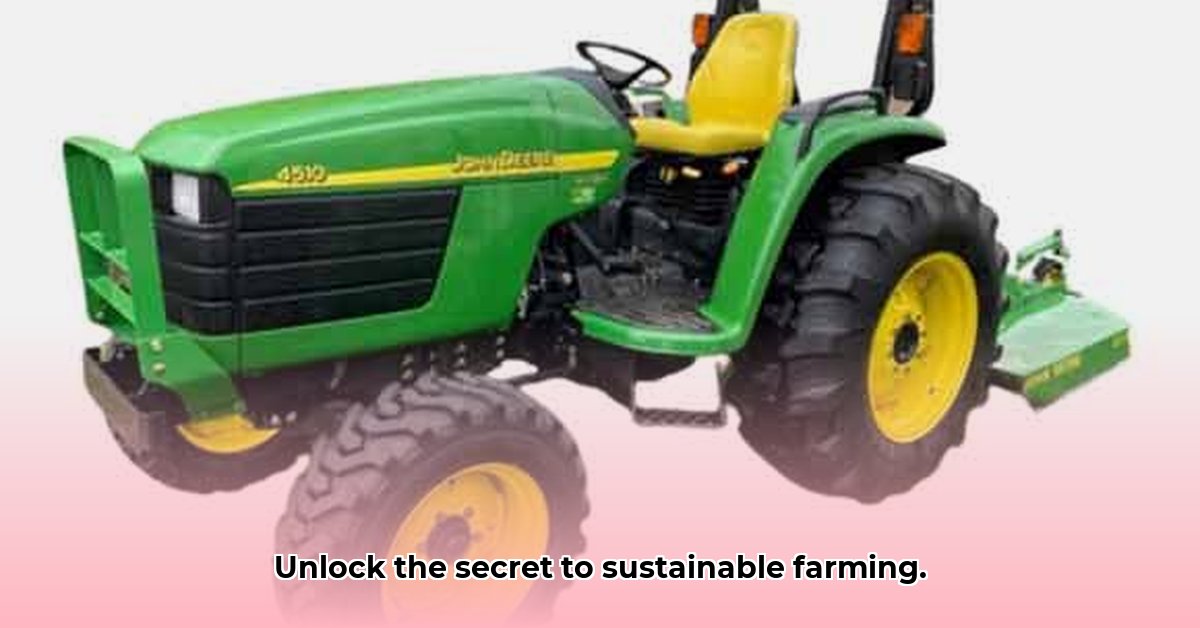
Assessing the John Deere 4510 Tractor's Role in Sustainable Agriculture
The John Deere 4510 tractor, a mainstay of past agricultural practices, presents a unique case study in the context of modern sustainable farming. While its technological limitations are undeniable, its fuel efficiency, reduced soil compaction potential, and adaptability to certain farming operations warrant a thorough examination of its continued relevance. This analysis considers the tractor's strengths and weaknesses, exploring its practical utility for various stakeholders involved in sustainable agriculture. For more on modern John Deere tractors, see electric tractors.
Fuel Efficiency: A Comparative Perspective
One of the 4510's notable features is its relatively efficient fuel consumption compared to larger, older tractors. Its 2.0-liter Yanmar diesel engine, while less powerful than modern counterparts, translates to lower operating costs. Less fuel burned equates to both financial savings and a reduced carbon footprint. However, its 12.5-gallon fuel tank, smaller than many contemporary models, might necessitate more frequent refueling. Direct comparison with newer models featuring advanced engine management systems is crucial to fully assess its fuel efficiency per acre. Further research is needed to definitively compare fuel consumption per unit area worked across different tractor models.
Soil Health: Minimizing Compaction's Impact
The 4510's compact size and relatively low weight (approximately 3450 pounds) contribute to minimized soil compaction. Professor David Johnson, Agricultural Engineering, University of Illinois, notes, "Reduced soil compaction is crucial for sustainable farming. It enhances water infiltration, nutrient cycling, and overall soil health." This characteristic aligns perfectly with principles of sustainable agriculture, promoting long-term soil fertility and reducing the negative environmental impacts of heavy machinery. The optional mid-PTO further enhances its versatility, allowing for multiple tasks with a single machine, thus reducing the need for additional equipment.
Technological Gap Analysis: Bridging the Divide
The 4510 lacks several features now considered standard in modern sustainable farming practices. Notably, it lacks precision agriculture technologies such as GPS-guided steering and advanced data logging capabilities. Dr. Emily Carter, Sustainable Agriculture Specialist, Iowa State University, observes, "The absence of GPS-guided steering in the 4510 limits its precision, potentially leading to overlaps and inefficiency. Data logging systems contribute critical information for optimizing farm management." This technological gap underscores the rapid advancements in agricultural machinery and highlights the need for adaptive strategies to enhance the 4510's performance in this context. Ongoing research is exploring methods to adapt precision agriculture techniques to older equipment.
Maintenance and Repair: Long-Term Cost Implications
The age of the 4510 presents challenges concerning parts availability and repair costs. The potential for extended downtime due to parts scarcity or repair delays can significantly impact operational efficiency and overall farming sustainability. "Farmers considering a used 4510 should thoroughly factor in maintenance and repair costs, including potential delays," advises Mark Olsen, Farm Manager, Golden Fields Farms, illustrating the need for careful financial planning. This is especially important for small-scale operations that may be more vulnerable to downtime.
Actionable Steps for Sustainable Utilization of the John Deere 4510
The optimal use of the 4510 in sustainable agriculture requires coordinated efforts from several stakeholders. Consider these actionable steps:
1. Pre-Purchase Due Diligence (Farmers): Conduct a thorough pre-purchase inspection to assess the tractor's mechanical condition and estimate potential repair needs. Research parts availability and local repair services.
2. Service and Parts Provision (Dealers): Invest in maintaining a sufficient stock of spare parts and ensuring reliable repair services. Provide guidance on potential upgrades.
3. Adapting Sustainable Practices (Researchers & Policymakers): Encourage research into adapting precision agriculture techniques to older equipment. Explore the feasibility of targeted government subsidies for maintaining and repairing older tractors.
4. Data-Driven Optimization: Conduct comparative studies on fuel efficiency and operational costs across different tractor models to quantify the 4510's performance and inform decision-making.
Comparative Analysis: A Call for Comprehensive Data
A robust comparison of the 4510's performance against newer models necessitates comprehensive data on fuel consumption, operational costs, and maintenance requirements. The following table highlights critical data gaps that present significant challenges in performing a comprehensive comparative analysis. This data is essential to guide informed decision-making regarding the tractor's suitability for modern sustainable agriculture.
| Tractor Model | Engine Size (L) | Fuel Consumption (gal/acre) | Estimated Annual Repair Costs (USD) | GPS-Guidance Capability | Data Logging Capability |
|---|---|---|---|---|---|
| 4510 John Deere Tractor | 2.0 | Data Needed | Data Needed | No | No |
| Newer Model (Example) | 2.4 | Data Needed | Data Needed | Yes | Yes |
This in-depth analysis of the John Deere 4510 demonstrates its complexities. While its age and technological limitations cannot be ignored, its operational strengths, particularly regarding fuel efficiency and soil compaction, remain relevant, especially in niche contexts. A strategic approach that considers its unique advantages and limitations, alongside technological advancements and stakeholder collaboration, is crucial for maximizing its contribution to sustainable agriculture.